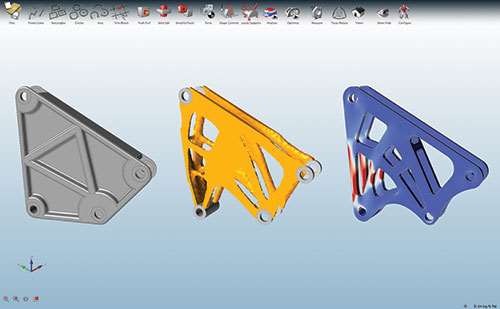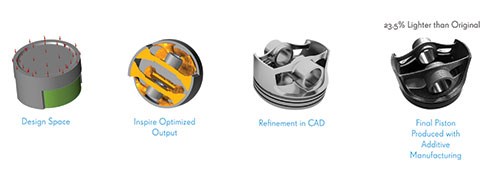Topology Optimization Explained
Topology optimization cuts part development time and costs, material consumption, and product weight. And it works with additive, subtractive, and all other types of manufacturing processes, too.
Topology optimization balances material use against the stiffness of a part. In the past two years, it has gained popularity because of its availability in computer-aided design (CAD) software that is both easy-to-use and affordable. Also, the optimization is great at creating strong, lightweight parts with less material.
Last, topology optimization shortens that design process considerably. From a designer’s standpoint, after applying the optimization, says Russell Vernon, application engineer at solidThinking (solidThinking.com), “You’re basically starting with an ideal solution, from a mathematically efficient design.” That ideal is a design already optimized for material consumption, product weight, and manufacturability. These are key criteria for parts created through additive manufacturing, mold making, and many other conventional manufacturing operations, such as casting and machining.
One such CAD package is Inspire from solidThinking, a wholly owned subsidiary of Altair (altair.com). Inspire, which works on both Windows and Apple computers, may be considered light on CAD—it’s fine for geometric modeling, but it works mostly with existing CAD tools—but it is heavy on topology opti-mization. The combination lets product designers, engineers, and even people not expert in designing or engineering generate and investigate structurally efficient part and product designs.
Analyzing topology
Topology optimization is a mathematical approach, introduced in 1988, for optimizing structures. It selects the elements in a finite element mesh (the design space) that best maximize the tradeoffs in both minimizing material usage and maximizing part strength for a given manufacturing process. The approach was commercialized as a solver, but relegated to high-end analysis because it required a preprocessor solver for meshing.
In Inspire, explains Vernon, “The topology optimization is all a finite element analysis [FEA] process. It creates a material layout within a given design space, for a given set of loads and constraints, in the most efficient way to meet the required performance targets.”
Interestingly, FEA and topology optimization work toward optimal designs from opposite directions. In FEA, a part shape is imported, loads and constraints are defined, and then a simulation confirms whether the shape satisfies the loads and constraints. In topology optimization, the loads and constraints are defined first, a volume that the part will occupy is defined, and then from the simulation, the software generates a part shape that satisfies the loads and constraints while minimizing the design goals of minimum part weight and maximum part stiffness.
The topology optimization in Inspire starts with solid geometry, which can be imported directly for all major CAD systems or imported as a neutral CAD file (such as IGES, Parasolids, and STEP). Then the design engineer inputs loads and manufacturing constraints. “The tricky part, which requires some intuition,” says Vernon, “is in how the model is loaded and supported to accurately depict how the final part will be used.”
At this point, the software takes over. All the meshing and other FEA operations for topology optimization are done in the background. These operations are basically a series of iterative analyses that vary the density of each element in the mesh—element by element. The solver determines whether the specific element needs to be in the design in order to satisfy stiffness, lightweighting, and other design requirements. “The density of the material is essentially a variable,” explains Tony Norton, executive vice president, Americas, for Altair ProductDesign, Inc. “Material is removed from regions that are less essential for carrying the loads.”
The FEA module in Inspire lets design engineers see how loads are applied and how the model will move as a result, as well as perform some basic modal analysis, such as natural frequencies in normal modes, and see mode shapes. Designs finished in Inspire will still need to be validated (post analysis) using an advanced analysis tools, points out Vernon.
Pretty, and pretty efficient results
Think of topology optimization as a way of carving out excess material in a design. “Design lightweight in, instead of engineering mass out when starting with the ideal solution,” says Vernon. Sure, a block of metal will work for an automobile pedal, but a ribbed piece of plastic will be lighter, cheaper, easier to make, and probably just as strong.
“Inspire helps design engineers follow the functional and resource-efficient design rules found within nature, an approach often called ‘biomimicry,’” continues Vernon. The resulting designs often look like biological structures found in nature, such as honeycomb, skeletal, and fractal shapes that feature curvy surfaces, bends and twists, pattern repetition, and the use of loads in tension.
These shapes that are easily produced using additive manufacturing methods. For example, HardMarque Future Factories, a Melbourne, Australia-based industrial design and additive manufacturing studio, used Inspire to lightweight a piston made of titanium in an additive manufacturing process. The final piston design weighed 289 grams, 23.5% lighter than the 378-gram original stock piston, yet just as strong. “The lighter your internal components are, the lower your carbon footprint is,” says Nick Hard, director of HardMarque. “And not only that, because it’s additive manufacturing and not subtractive manufacturing, you are not wasting 90% of a block of metal to achieve the finished product. You are only consuming the material you need for the product.”
RELATED CONTENT
-
On Automotive: An All Electric Edition
A look at electric vehicle-related developments, from new products to recycling old batteries.
-
GM Develops a New Electrical Platform
GM engineers create a better electrical architecture that can handle the ever-increasing needs of vehicle systems
-
Plastics: The Tortoise and the Hare
Plastic may not be in the news as much as some automotive materials these days, but its gram-by-gram assimilation could accelerate dramatically.










